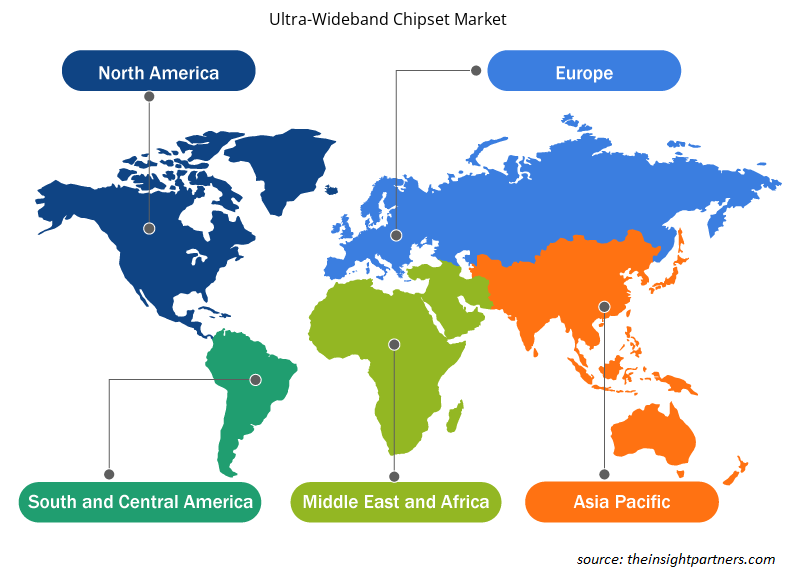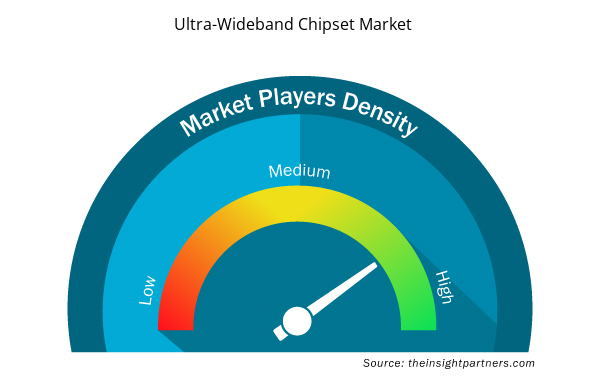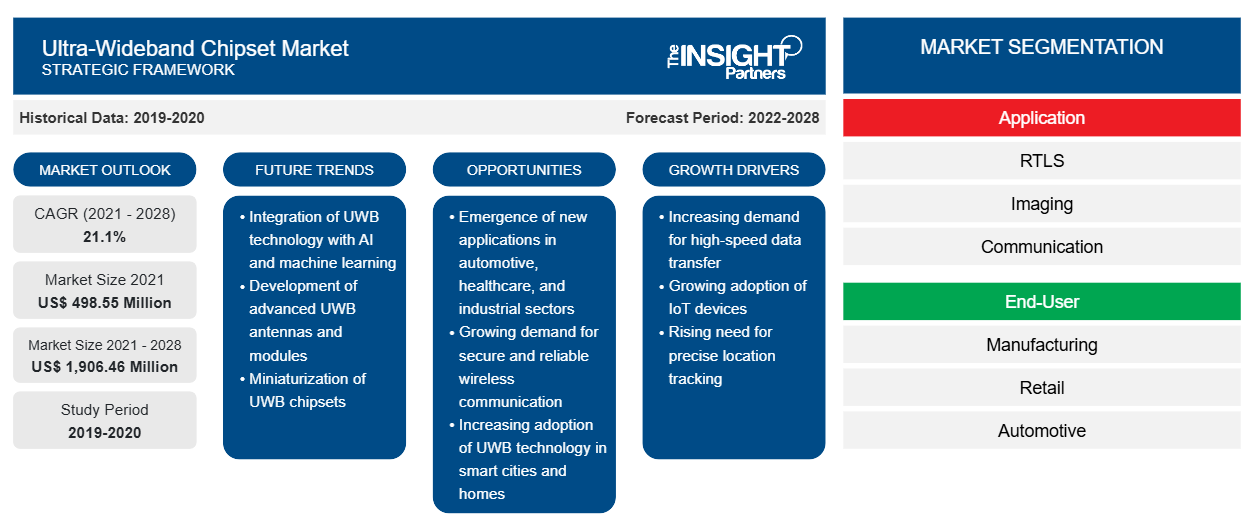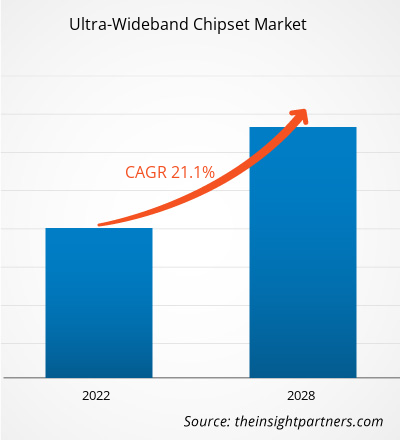2021 年超宽带芯片组市场价值为 4.9855 亿美元,预计到 2028 年将达到 19.0646 亿美元;预计 2021 年至 2028 年的复合年增长率为 21.1%。
超宽带是实时定位系统 (RTLS) 中采用的新兴技术之一,由于其跟踪物体的精度更高,因此具有相当大的增长潜力。与其他RTLS 技术(如 RFID)相比,UWB 技术具有高精度、大范围和低功耗的特点;这导致 UWB 技术在需要高精度的应用中的普及率不断提高。由于 UWB 技术的精度更高,许多 RTLS 终端用户已从 RFID 和 Wi-Fi 转向 UWB 技术,以提高产品的效率。此外,集成 UWB 的 RTLS 解决方案为 RTLS 应用提供了各种优势,从而推动了超宽带芯片组市场的发展
定制此报告以满足您的需求
您可以免费定制任何报告,包括本报告的部分内容、国家级分析、Excel 数据包,以及为初创企业和大学提供优惠和折扣
- 获取此报告的关键市场趋势。这个免费样品将包括数据分析,从市场趋势到估计和预测。
COVID-19 疫情对亚太超宽带芯片组市场规模的影响
由于 COVID-19 疫情,多个地区遭受重创,尤其是亚太地区。全球制造业一直面临产量低迷和供应链疲软的问题。此外,劳动力短缺也影响了制造业。基于 UWB 的系统生产设施也要么关闭,要么无法达到总产能,这对公司 2020 年至 2021 年中期的收入产生了负面影响,并导致短期内增长放缓。然而,随着远程监控技术的使用日益增多,软件管理工具可能会在后疫情时期得到更广泛的采用。因此,COVID-19 对全球超宽带芯片组市场的整体影响为低至中等。
市场洞察 – 超宽带芯片组市场
个人和消费设备跟踪中越来越多地采用 UWB 技术,推动超宽带芯片组市场增长
UWB 显著增强了笔记本电脑、电视和音频等家庭娱乐产品的消费者体验。这导致 UWB 技术的采用率不断提高,并最终推动了超宽带芯片组市场的增长。它也被用于追踪个人物品。例如,用于空间感知的 Apple U1 芯片集成在 iPhone 11、12 和 13 中。此外,继 Apple 之后,各智能手机制造商也在产品中集成了 UWB 技术,促进了超宽带芯片组市场的增长。此外,2021 年 4 月,Apple 发布了采用 UWB 技术的 AirTag,随后三星正式推出了包含 UWB 的 Galaxy SmartTag+ 追踪器。因此,采用率的激增促进了超宽带芯片组市场的增长。 significantly enhances the consumer experience of home entertainment products such as laptops, TV, and audio. This has led to increasing UWB technology adoption and eventually boosts the ultra-wideband chipset market growth. It is also being used to track the personal item. For example, the Apple U1 chip for spatial awareness is integrated into iPhones 11, 12, and 13. In addition, after Apple, various smartphone manufacturers have integrated UWB technology in their products, contributing to the growth of the ultra-wideband chipset market. Moreover, in April 2021, Apple released AirTag with UWB technology, post which Samsung officially launched its Galaxy SmartTag+ tracker comprising UWB. Thus, the surge in adoption rate contributes to the growth of the ultra-wideband chipset market.
基于应用的洞察
根据产品,超宽带芯片组市场细分为 RTLS、成像和通信。通信部门在 2021 年引领了市场。UWB 无线通信在 3.1 至 10.6 GHz 的宽频谱上传输大量数据。它包括测距、身份验证、无线 USB 和数据传输应用。此外,由于移动自组织网络和通过无线传感器网络进行数据收集等新兴应用,对无线宽带通信系统的需求显着增加,从而推动了对超宽带芯片组市场规模的需求。ultra-wideband chipset market is segmented into RTLS, imaging, and communication. The communication segment led the market in 2021. UWB wireless communication transmits considerable data over a broad frequency spectrum ranging from 3.1 to 10.6 GHz. It includes ranging, authentication, wireless USB, and data transfer applications. Furthermore, the demand for wireless wideband communications systems has increased significantly, owing to emerging applications such as mobile ad-hoc networking and data collection through a ultra-wideband chipset market size.
超宽带芯片组市场根据应用、最终用户和地理位置进行细分。根据类型,超宽带芯片组市场分为成像测量系统和非成像测量系统。根据最终用户,超宽带芯片组市场细分为制造、零售、汽车、医疗保健和消费电子产品。从地理位置上看,超宽带芯片组市场细分为北美、欧洲、亚太地区 (APAC) 和世界其他地区。ALEREON, INC.;Apple Inc.;Bespoon SAS;Decawave Limited;TAIYO YUDEN CO., LTD.;Taoglas;Johanson Technology, Inc.;NOVELDA;NXP Semiconductors NV;和 Pulse-Link, inc. 是超宽带芯片组市场研究中介绍的关键参与者。ultra-wideband chipset market is segmented based on application, end user, and geography. Based on type, the ultra-wideband chipset market is categorized into imaging measurement systems and non-imaging measuring systems. Based on end user, the ultra-wideband chipset market is segmented into manufacturing, retail, automotive, healthcare, and consumer electronics. Geographically, the ultra-wideband chipset market is segmented into North America, Europe, Asia Pacific (APAC), and the Rest of World. ALEREON, INC.; Apple Inc.; Bespoon SAS; Decawave Limited; TAIYO YUDEN CO., LTD.; Taoglas; Johanson Technology, Inc.; NOVELDA; NXP Semiconductors N.V.; and Pulse-Link, inc. are among the key players profiled during the ultra-wideband chipset market study.
超宽带芯片组市场区域洞察 Chipset Market Regional Insights
Insight Partners 的分析师已详尽解释了预测期内影响超宽带芯片组市场的区域趋势和因素。本节还讨论了北美、欧洲、亚太地区、中东和非洲以及南美和中美洲的超宽带芯片组市场细分和地理位置。Ultra-Wideband Chipset Market throughout the forecast period have been thoroughly explained by the analysts at Insight Partners. This section also discusses Ultra-Wideband Chipset Market segments and geography across North America, Europe, Asia Pacific, Middle East and Africa, and South and Central America.

- 获取超宽带芯片组市场的区域特定数据Ultra-Wideband Chipset Market
超宽带芯片组市场报告范围
| 报告属性 | 细节 |
|---|---|
| 2021 年市场规模 | 4.9855亿美元 |
| 2028 年市场规模 | 19.0646亿美元 |
| 全球复合年增长率(2021 - 2028) | 21.1% |
| 史料 | 2019-2020 |
| 预测期 | 2022-2028 |
| 涵盖的领域 | 按应用
|
| 覆盖地区和国家 | 北美
|
| 市场领导者和主要公司简介 |
|
超宽带芯片组市场参与者密度:了解其对业务动态的影响
超宽带芯片组市场正在快速增长,这得益于终端用户需求的不断增长,而这些需求又源于消费者偏好的不断变化、技术进步以及对产品优势的认识不断提高等因素。随着需求的增加,企业正在扩大其产品范围,进行创新以满足消费者的需求,并利用新兴趋势,从而进一步推动市场增长。
市场参与者密度是指在特定市场或行业内运营的企业或公司的分布情况。它表明在给定市场空间中,相对于其规模或总市场价值,有多少竞争对手(市场参与者)存在。
在超宽带芯片组市场运营的主要公司有:
- ALEREON 公司
- 苹果公司
- 贝斯蓬公司
- Decawave 有限公司
- 太阳诱电株式会社
免责声明:上面列出的公司没有按照任何特定顺序排列。

- 获取超宽带芯片组市场顶级关键参与者概览
超宽带芯片组市场的参与者主要致力于开发先进、高效的产品。
- 2021 年,苹果公司推出了搭载 U1 UWB 芯片组的 AirTag,旨在使用 iPhone 追踪物体。
- 2020年,三星推出了新款智能手机三星Galaxy Note20 Ultra,搭载恩智浦半导体的超宽带芯片组。
- 历史分析(2 年)、基准年、预测(7 年)及复合年增长率
- PEST 和 SWOT 分析
- 市场规模价值/数量 - 全球、区域、国家
- 行业和竞争格局
- Excel 数据集


- Long Read Sequencing Market
- Emergency Department Information System (EDIS) Market
- Small Satellite Market
- Vaginal Specula Market
- Resistance Bands Market
- Semiconductor Metrology and Inspection Market
- Microcatheters Market
- Integrated Platform Management System Market
- Electronic Shelf Label Market
- Europe Tortilla Market

Report Coverage
Revenue forecast, Company Analysis, Industry landscape, Growth factors, and Trends

Segment Covered
This text is related
to segments covered.

Regional Scope
North America, Europe, Asia Pacific, Middle East & Africa, South & Central America

Country Scope
This text is related
to country scope.
常见问题
The automotive and transportation industry has witnessed a series of new and emerging UWB technology applications for the past few years and wireless technology is majorly used in automobiles for radio reception and navigation purposes. Additionally, the introduction of advanced features in cars such as keyless entry and tire pressure monitoring has also led to the higher adoption of wireless data transmission techniques which will create growth opportunities of the market during the forecast period.
Ongoing advancements in new application areas of UWB technology in the wireless sensor network and growing deployment of the technology in mobile devices have increased the scope of UWB technology. Furthermore, UWB is one of the fastest-growing technologies adopted in RTLS systems, with a considerable growth potential due to its accuracy in tracking assets. UWB technology and the next-generation BLE beacon technology are likely to be in demand by the providers of RTLS solutions and asset tracking systems during the forecast period. Thus, the adoption of RTLS (real-time location system) of ultra-wideband chipsets to track or locate people or objects within confined areas such as shopping malls, hospitals, and airports is expected to boost the global ultra-wideband (UWB) chipset market during the forecast period.
The communication segment is expected to dominate the market during the forecast period. UWB communication utilizes wide bandwidth and supports high data rates. UWB wireless communication transmits a huge amount of data over a wide frequency spectrum between 3.1 to 10.6GHz. It includes applications such as ranging, authentication, wireless USB, data transfer. USB UWB communication mainly uses low-powered radio signals of short pulses for the transmission and reception of data. Recently, ultra-wideband antenna applications have grown to include a wide range of computing devices and Internet of Things (IoT) peripherals. Most of these wireless communication systems employ a UWB antenna for data transmission, reception, positioning, location identification, sensing, and tracking. Depending on the radiation characteristics of the communication system, UWB antenna design varies, and each application requires customized UWB antennas. Thus, the above factor will lead market players to invest more on development of the products.
Ultra-wideband technology is considered to be the fastest-growing technology, which is predicted to notably enhance the consumers experience related to smartphones, TVs, home entertainment products, audio equipment, and laptops. UWB is known for offering wireless connections at speeds of around 110 Mbit/sec and higher, thus making it suitable for connecting televisions to recorders and DVD players, home audio equipment, and personal video recorders (PVRs). UWB is able to meet the low power requirements of handheld electronics and offers a low-cost solution that is relevant for wide consumer adoption. The major use of UWB chipsets is expected to be across smartphones, wearable, Ipad, homepod, and mini watches. The devices that are equipped with the Apple-designed U1 chip feature ultra-Wideband technology for spatial awareness. UWB is available for iPhone 11, iPhone 12, and iPhone 13 variants. UWB is not available in all the countries of the world and is subject to international regulatory requirements. In the consumer electronics sector, the use of UWB technology is anticipated to be the most for smartphones.
In 2020, Asia Pacific holds the largest share of the global ultra-wideband chipset market owing to the integration of UWB technology in consumer electronic devices for RTLS, imaging, and communication. China leads the region due to the heavy investments in research and development of UWB technology. Moreover, the increasing healthcare industry in the region and the need for highly accurate imaging and detection systems are among the factors driving the market growth.
NXP Semiconductors, Qorvo, Decaware, Alereon and Apple are the five key market players operating in the Global Ultra-Wideband Chipset Market. listing of Key Five Players in the Global Ultra-Wideband Chipset Market by giving weightage to following key parameters: overall revenue, segmental revenue, brand image & industry experience, current automatic tolling system portfolio, innovative and advanced technology integration/material enhancements, customer base, geographical reach, new product launches, partnerships, mergers & acquisitions, and other market related activities.
Trends and growth analysis reports related to Electronics and Semiconductor : READ MORE..
The List of Companies - Ultra Wideband Chipset Market
- ALEREON, INC.
- Apple Inc.
- Bespoon SAS
- Decawave Limited
- TAIYO YUDEN CO., LTD.
- Johanson Technology, Inc.
- NOVELDA AS
- NXP Semiconductors N.V.
- Pulse-Link, inc.
- Taoglas
The Insight Partners performs research in 4 major stages: Data Collection & Secondary Research, Primary Research, Data Analysis and Data Triangulation & Final Review.
- Data Collection and Secondary Research:
As a market research and consulting firm operating from a decade, we have published and advised several client across the globe. First step for any study will start with an assessment of currently available data and insights from existing reports. Further, historical and current market information is collected from Investor Presentations, Annual Reports, SEC Filings, etc., and other information related to company’s performance and market positioning are gathered from Paid Databases (Factiva, Hoovers, and Reuters) and various other publications available in public domain.
Several associations trade associates, technical forums, institutes, societies and organization are accessed to gain technical as well as market related insights through their publications such as research papers, blogs and press releases related to the studies are referred to get cues about the market. Further, white papers, journals, magazines, and other news articles published in last 3 years are scrutinized and analyzed to understand the current market trends.
- Primary Research:
The primarily interview analysis comprise of data obtained from industry participants interview and answers to survey questions gathered by in-house primary team.
For primary research, interviews are conducted with industry experts/CEOs/Marketing Managers/VPs/Subject Matter Experts from both demand and supply side to get a 360-degree view of the market. The primary team conducts several interviews based on the complexity of the markets to understand the various market trends and dynamics which makes research more credible and precise.
A typical research interview fulfils the following functions:
- Provides first-hand information on the market size, market trends, growth trends, competitive landscape, and outlook
- Validates and strengthens in-house secondary research findings
- Develops the analysis team’s expertise and market understanding
Primary research involves email interactions and telephone interviews for each market, category, segment, and sub-segment across geographies. The participants who typically take part in such a process include, but are not limited to:
- Industry participants: VPs, business development managers, market intelligence managers and national sales managers
- Outside experts: Valuation experts, research analysts and key opinion leaders specializing in the electronics and semiconductor industry.
Below is the breakup of our primary respondents by company, designation, and region:

Once we receive the confirmation from primary research sources or primary respondents, we finalize the base year market estimation and forecast the data as per the macroeconomic and microeconomic factors assessed during data collection.
- Data Analysis:
Once data is validated through both secondary as well as primary respondents, we finalize the market estimations by hypothesis formulation and factor analysis at regional and country level.
- Macro-Economic Factor Analysis:
We analyse macroeconomic indicators such the gross domestic product (GDP), increase in the demand for goods and services across industries, technological advancement, regional economic growth, governmental policies, the influence of COVID-19, PEST analysis, and other aspects. This analysis aids in setting benchmarks for various nations/regions and approximating market splits. Additionally, the general trend of the aforementioned components aid in determining the market's development possibilities.
- Country Level Data:
Various factors that are especially aligned to the country are taken into account to determine the market size for a certain area and country, including the presence of vendors, such as headquarters and offices, the country's GDP, demand patterns, and industry growth. To comprehend the market dynamics for the nation, a number of growth variables, inhibitors, application areas, and current market trends are researched. The aforementioned elements aid in determining the country's overall market's growth potential.
- Company Profile:
The “Table of Contents” is formulated by listing and analyzing more than 25 - 30 companies operating in the market ecosystem across geographies. However, we profile only 10 companies as a standard practice in our syndicate reports. These 10 companies comprise leading, emerging, and regional players. Nonetheless, our analysis is not restricted to the 10 listed companies, we also analyze other companies present in the market to develop a holistic view and understand the prevailing trends. The “Company Profiles” section in the report covers key facts, business description, products & services, financial information, SWOT analysis, and key developments. The financial information presented is extracted from the annual reports and official documents of the publicly listed companies. Upon collecting the information for the sections of respective companies, we verify them via various primary sources and then compile the data in respective company profiles. The company level information helps us in deriving the base number as well as in forecasting the market size.
- Developing Base Number:
Aggregation of sales statistics (2020-2022) and macro-economic factor, and other secondary and primary research insights are utilized to arrive at base number and related market shares for 2022. The data gaps are identified in this step and relevant market data is analyzed, collected from paid primary interviews or databases. On finalizing the base year market size, forecasts are developed on the basis of macro-economic, industry and market growth factors and company level analysis.
- Data Triangulation and Final Review:
The market findings and base year market size calculations are validated from supply as well as demand side. Demand side validations are based on macro-economic factor analysis and benchmarks for respective regions and countries. In case of supply side validations, revenues of major companies are estimated (in case not available) based on industry benchmark, approximate number of employees, product portfolio, and primary interviews revenues are gathered. Further revenue from target product/service segment is assessed to avoid overshooting of market statistics. In case of heavy deviations between supply and demand side values, all thes steps are repeated to achieve synchronization.
We follow an iterative model, wherein we share our research findings with Subject Matter Experts (SME’s) and Key Opinion Leaders (KOLs) until consensus view of the market is not formulated – this model negates any drastic deviation in the opinions of experts. Only validated and universally acceptable research findings are quoted in our reports.
We have important check points that we use to validate our research findings – which we call – data triangulation, where we validate the information, we generate from secondary sources with primary interviews and then we re-validate with our internal data bases and Subject matter experts. This comprehensive model enables us to deliver high quality, reliable data in shortest possible time.


 获取此报告的免费样本
获取此报告的免费样本